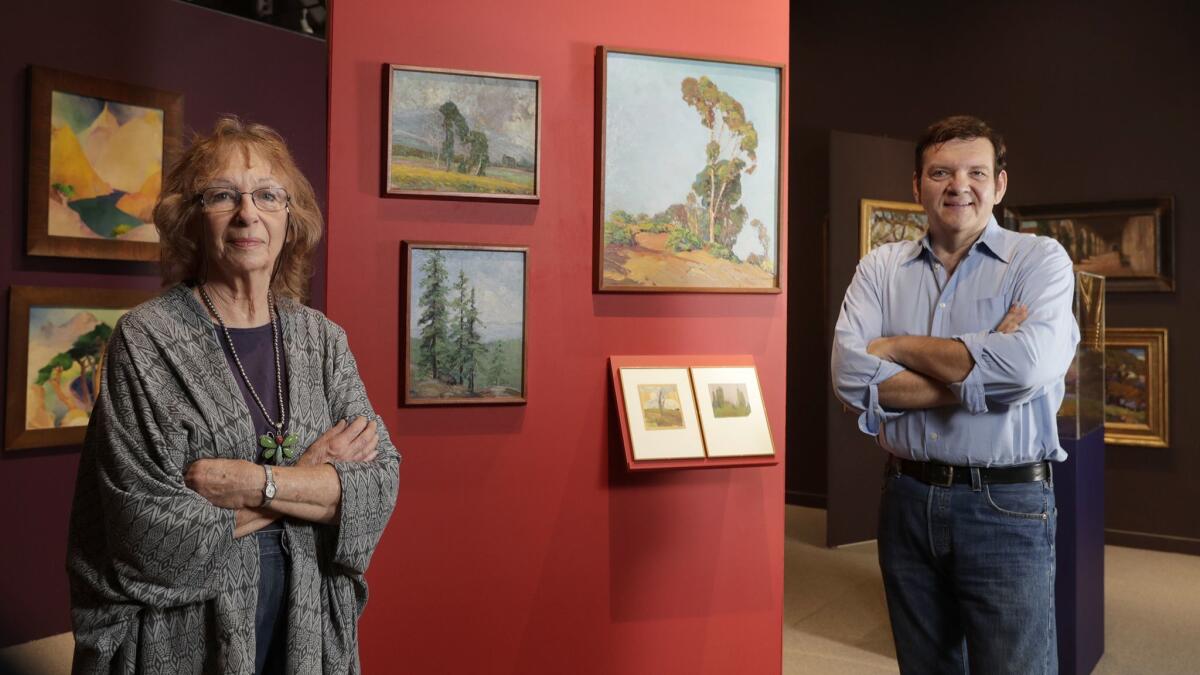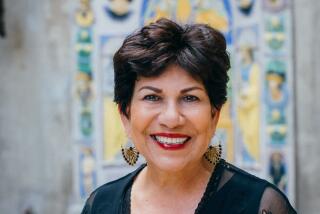The conservator who is bringing lost stories of California’s pioneering female artists to light

The life of Ruth Miller Kempster reads as if it could have come out of an Edith Wharton novel — if Wharton had set one of her stories in 1930s California with a strong-willed female painter protagonist chafed by convention.
Born in 1904, Kempster came from a well-heeled family that settled in Pasadena and helped establish the city of Fontana. She was expected to attend Vassar, like her mother and sisters, but put on a display of hysterics that got her dispatched to art school instead. She studied in Paris — at a time when unwed women were not allowed to draw from nude models at L’École de Beaux Arts — and ended up in Italy, living with a young Italian painter.
“When the family got wind of it, they got on a boat and off they went to get her,” says Maurine St. Gaudens, a conservator and curator familiar with the artist’s work. But that wasn’t the end of Kempster’s adventures — or her career as an artist.
Kempster went on to produce canvases in a stark, modern style that fused social realism with the surreal: self-portraits, industrial scenes and proto-feminist paintings such as “Housewife,” created circa 1935, which shows a woman bearing a quiet look of desperation as she scrubs the dishes. The artist racked up ribbons at juried exhibitions — including a silver medal for a painting of wrestlers locked in battle in connection with the 1932 Olympic Games in Los Angeles. The judge on that competition? Mexican muralist David Alfaro Siqueiros.
Yet Kempster died in relative obscurity. Her last significant exhibition before her 1978 death in Santa Barbara had been a solo show at the Pasadena Art Institute in 1953 (later to become the Norton Simon Museum).
Kempster of course isn’t the only female artist whose work has been nearly forgotten.
Which is why, for more than a decade, St. Gaudens has made it her mission to record the work and the stories of California’s early female artists, Kempster among them.
Two years ago the Pasadena-based conservator published “Emerging From the Shadows: A Survey of Women Artists Working in California, 1860-1960,” a hefty, four-volume reference set that gathers the biographies and works of more than 300 artists whose work had been barely or erratically documented.
And last week she could be found putting the finishing touches on a new exhibition at the Pasadena Museum of History that further fills out these women’s stories in ink, oil and canvas. “Something Revealed: California Women Artists Emerge, 1860-1960” contains more than 270 objects by more than 100 women artists who were working in California during its most formative period.
Featured prominently are numerous canvases by Kempster, including her absorbing “Housewife,” as well as dozens of other artists: Vivian Stringfield (1881-1933), whose paintings fused elements of Japanese landscapes with an acid color palette. Elizabeth Borglum (1848-1922), who produced portraiture and sensitively rendered California landscapes at twilight, but is better known for having been married to Mt. Rushmore sculptor Gutzon Borglum. And Nelbert Chouinard (1879-1969), a landscape painter who arrived in Southern California as an art teacher and went on to found the Chouinard Art Institute in Los Angeles (which would later evolve into the California Institute of the Arts).
“Nobody has seen any of her paintings in decades — they simply haven’t been exhibited,” says St. Gaudens, as she gestures at a trio of Chouinard’s plein air California landscapes.

For St. Gaudens, the exhibition has been an odyssey into the history of art, the history of California and the under-recorded history of women in both arenas.
“It’s so rewarding,” she adds, “to bring these women to the public in a museum.”
The project is rooted in St. Gaudens’ own work as a conservator of oil paintings. For years she’s had paintings materialize in her studio whose origins weren’t always entirely clear.
“They’d be these wonderful paintings, finely executed and the signature would often be genderless — initials,” she says. “And sometimes you’d get this really great painting and all you’d find is, ‘She was a teacher, she lived with her parents and she was a spinster.’”
As St. Gaudens looked into the lives and work of the women whose paintings she’d been charged with conserving, she began to compile information about them — figuring that at some point she might publish it in a book that could aid other conservators and historians. But what began rather informally soon ballooned into a full-blown, multi-volume research project — featuring more than 320 artists from all over the state, dating back to the mid-19th century.
“I desperately needed help,” she recalls. “The book was a monster.”
She found a willing partner in independent researcher and historian Joseph Morsman, who helped her dig into archives and locate surviving family members (and who has helped her organize the exhibition in Pasadena).
The process of uncovering these histories has been an odyssey.
“I revealed to one family that their mother had been married before she was married to their father — and the family didn’t even know about it,” says Morsman. “I reunited cousins who didn’t know about each other. A lot of times, if a woman moved from the East Coast, she often lost touch with the family. Or if they divorced, they came out here and started a new identity.”
Part of Morsman’s job was sorting out a woman’s various identities over time, since a single artist might create work under her maiden name and perhaps one or more married ones. She might also change names just because — such as Chouinard, who called herself “Nelbert” because she disliked her given name, “Nellie.”
One highlight was coming across the story of Pauline Powell Burns (1872-1912), who is believed to be the first African American female artist to exhibit her work at a California institution: the Mechanics’ Institute Fair in San Francisco in 1890.
They couldn’t find enough surviving artwork to give her a full entry in the directory, but they did locate a single painting by the artist in a private collection in New York and have included it in the exhibition — a still life likely painted in the late 19th century.
“It took me a good year to try to track down examples of Pauline Powell Burns’ work,” says Morsman. “We simply couldn’t find the work.”
The project helped flesh out the biographies of dozens of women who maybe had been reduced to just a few lines in an obituary by the time of their deaths. Many of these artists worked as teachers, influencing generations of art students all over the state.
“They would be teachers here in San Diego or wherever and then class would break and they’d go to New York or Chicago or they’d go to Europe,” says Morsman.
“They were not isolated,” adds St. Gaudens. “They were reciprocal messengers. They went to Europe and then they would pass that knowledge on to their students. We found them to be so adventurous. There was one who would saddle up her mules with tequila and go off to Mexico.”
Their research has also had the effect of bringing some of these works — many of which chronicle California, including long-gone sights such as L.A.’s old Chinatown and Chavez Ravine — into museums where they might be better preserved. Chouinard’s descendants have donated her landscapes to the Pasadena Museum of History. And the Huntington Library, Art Collections, and Botanical Gardens recently acquired Kempster’s award-winning wrestler canvas from 1931-32 titled “Struggle.”
“It was of interest to use because it was a solid example of this woman’s work and it won the silver model from the Olympics here in 1932,” says Catherine Hess, chief curator of European art at the Huntington. “And it fit into our collection areas, which is women artists of the American West.”
For St. Gaudens, the books and the exhibitions are now done, but she isn’t quite finished. Perhaps, she notes, the show might surface more hidden gems or valuable bits of information.
“We hope people will come out of the woodwork and help solve some of our mysteries,” she says.
When it comes to the work of women, there are still countless stories to be told.
“Something Revealed: California Women Artists Emerge, 1860-1960”
Where: Pasadena Museum of History, 470 W. Walnut St., Pasadena
When: Through March 31
Info: pasadenahistory.org
ALSO
From 125th Street in Harlem, Thelma Golden has changed the face of art all over the U.S.
Sign up for our weekly Essential Arts & Culture newsletter »
carolina.miranda@latimes.com | Twitter: @cmonstah
More to Read
The biggest entertainment stories
Get our big stories about Hollywood, film, television, music, arts, culture and more right in your inbox as soon as they publish.
You may occasionally receive promotional content from the Los Angeles Times.







